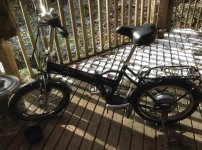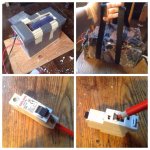Learning Curve
1 W
Hello, I am new here but have been reading up on the battery information posted here! It has been really helpful, and I am hoping to get some information specific to my exact situation.
I bought a relatively inexpensive electric bike back in 2008, and I am hoping to get it back on the road. The bike was made in China and I see where on the the gears it says Wuxing so I am thinking this is the manufacturer of my bike. I see where they have one that is similar still for sale. It is a folding bike with a brush-less 350 watt rear hub motor, and it originally came with a 36 volt 10 amp hour lithium battery. The controller has a 15 amp peak output capacity.
I live about 5 hilly miles from the nearest town, and only have time to go in about once a week. I used the bike during good weather for about a year and a 1/2, and then the battery lost the capacity to make the 10 mile round trip and I could not afford a replacement so I stopped riding it. (when I bought the bike I was told the battery was good for 1000 charge cycles and that a new replacement battery would cost $200... which was incorrect! The lithium batteries are good for 1000 cycles or two or 3 years, and loose capacity which each year, regardless of how many charge cycles there is)
So my ebike is 6 years old, but it has only been ridden about 300 miles, and except for a dead battery, I think it is still in perfect working condition.
I have saved up and I am planning on getting a 36 volt 15 amp hour Ping battery. As I understand it the LifePo4 batteries do not have such a strong tendency to loose capacity with each year and with care, this new battery should last me several years. I thought about getting the 10 amp hour, which would probably be sufficient, but about 1/3 of the route to town is up hill, and in 5 miles the road goes from sea level to an elevation of 400 feet. So the additional output capacity the 15 amp hour is capable of will probably help the battery survive longer.
My challenge is going to be connecting this up properly to my ebike, and creating a way to cycle the battery regularly, even if I do not ride the bike regularly. (Like during the winter) Electronics and wiring has never been something I have had any aptitude for. With the internet it seems it is possible to learn, which is what I hope to do!
I have been reading here, and Ping has been really helpful as well. But I am hoping people here can help me with a few of the details of how to do this, and I want to make sure I have the parts I need to do this when the battery arrives.
I would like to be able to easily unplug the battery from the controller and I see where many people recommend 45 amp Anderson power poles. But the people recommending this had 48 volt 20 amp hour batteries. Are Anderson power poles still the best way to easily disconnect and reconnect the battery and controller? Do I need 45 amp power poles for a 36 volt 15 amp hour battery, or would a lower amp rating for the power pole connectors be better for this type of battery?
I have also been reading that there is often a spark when the battery is first plugged in and I really would like to suppress this! I do not want to feel afraid of my electric bike and also it can be bone dry here in summer and sparks are just not a good idea.
Ping said for a small additional charge he can include a properly sized circuit breaker that can also work as an on off switch, so I am hoping that if I use this and have it off when I plug in the battery, that there will be no spark.
But any additional advice on how to avoid sparks would be appreciated!
I have connected up a trolling motor to run on a SLA battery and installed a circuit breaker in the 10 gauge positive line, so I am hoping if I managed to do that, I can also wire up the Lifepo4 battery to my ebike.
I am also hoping to have something like maybe a 36 volt head lamp that I could plug the battery into to drain it down 80 percent so I can then recharge it and cycle the battery during times I may not be able to ride the bike enough to keep the battery healthy. I have found a 36 volt 10 watt scooter head light that might work to do this. Would this work and if it would, roughly how long would it take a 10 watt 36 volt light to use up 80 percent of a 36 volt 15 amp hour battery?
I would post some pictures, but I need to figure out how to do that!
I bought a relatively inexpensive electric bike back in 2008, and I am hoping to get it back on the road. The bike was made in China and I see where on the the gears it says Wuxing so I am thinking this is the manufacturer of my bike. I see where they have one that is similar still for sale. It is a folding bike with a brush-less 350 watt rear hub motor, and it originally came with a 36 volt 10 amp hour lithium battery. The controller has a 15 amp peak output capacity.
I live about 5 hilly miles from the nearest town, and only have time to go in about once a week. I used the bike during good weather for about a year and a 1/2, and then the battery lost the capacity to make the 10 mile round trip and I could not afford a replacement so I stopped riding it. (when I bought the bike I was told the battery was good for 1000 charge cycles and that a new replacement battery would cost $200... which was incorrect! The lithium batteries are good for 1000 cycles or two or 3 years, and loose capacity which each year, regardless of how many charge cycles there is)
So my ebike is 6 years old, but it has only been ridden about 300 miles, and except for a dead battery, I think it is still in perfect working condition.
I have saved up and I am planning on getting a 36 volt 15 amp hour Ping battery. As I understand it the LifePo4 batteries do not have such a strong tendency to loose capacity with each year and with care, this new battery should last me several years. I thought about getting the 10 amp hour, which would probably be sufficient, but about 1/3 of the route to town is up hill, and in 5 miles the road goes from sea level to an elevation of 400 feet. So the additional output capacity the 15 amp hour is capable of will probably help the battery survive longer.
My challenge is going to be connecting this up properly to my ebike, and creating a way to cycle the battery regularly, even if I do not ride the bike regularly. (Like during the winter) Electronics and wiring has never been something I have had any aptitude for. With the internet it seems it is possible to learn, which is what I hope to do!
I have been reading here, and Ping has been really helpful as well. But I am hoping people here can help me with a few of the details of how to do this, and I want to make sure I have the parts I need to do this when the battery arrives.
I would like to be able to easily unplug the battery from the controller and I see where many people recommend 45 amp Anderson power poles. But the people recommending this had 48 volt 20 amp hour batteries. Are Anderson power poles still the best way to easily disconnect and reconnect the battery and controller? Do I need 45 amp power poles for a 36 volt 15 amp hour battery, or would a lower amp rating for the power pole connectors be better for this type of battery?
I have also been reading that there is often a spark when the battery is first plugged in and I really would like to suppress this! I do not want to feel afraid of my electric bike and also it can be bone dry here in summer and sparks are just not a good idea.
Ping said for a small additional charge he can include a properly sized circuit breaker that can also work as an on off switch, so I am hoping that if I use this and have it off when I plug in the battery, that there will be no spark.
But any additional advice on how to avoid sparks would be appreciated!
I have connected up a trolling motor to run on a SLA battery and installed a circuit breaker in the 10 gauge positive line, so I am hoping if I managed to do that, I can also wire up the Lifepo4 battery to my ebike.
I am also hoping to have something like maybe a 36 volt head lamp that I could plug the battery into to drain it down 80 percent so I can then recharge it and cycle the battery during times I may not be able to ride the bike enough to keep the battery healthy. I have found a 36 volt 10 watt scooter head light that might work to do this. Would this work and if it would, roughly how long would it take a 10 watt 36 volt light to use up 80 percent of a 36 volt 15 amp hour battery?
I would post some pictures, but I need to figure out how to do that!




